People Management in traditional projects had a command and control approach and hierarchical in nature. But more importantly the contributors had tightly coupled with their respective department or function.
Lets take an example of Project that requires Development, Testing, IT and Customer Support skills. The org structure would have vertical slicing clearly delineating respective departments of Development, Quality, IT and Support as shown in the diagram.
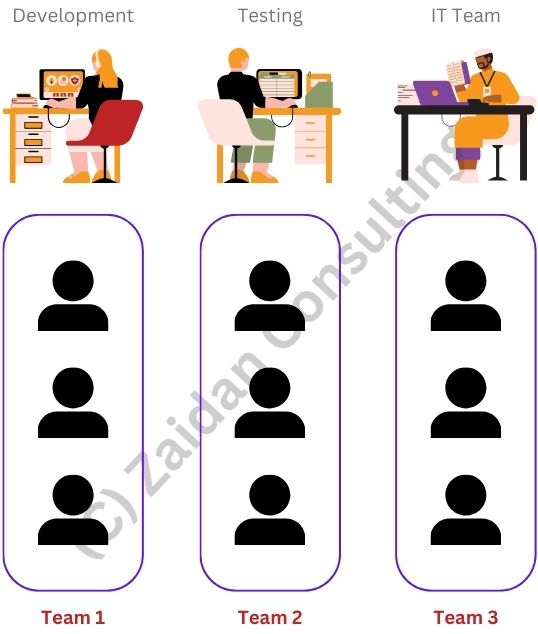
The contributing individuals still have their respective department as their home team. They may deliver for the Project with their skills, they still have their complete commitment towards their line manager or department. As a result most of the team members work part time for the Project or only available temporarily.
While this made sense during those times, it would not work well with teams that are delivering services or products particularly in a competitive market.
What is a Cross Functional Team?
A cross functional team is the exact opposite of the traditional team structure, while the intent remains the same. “Deliver successfully”. And how does it work.
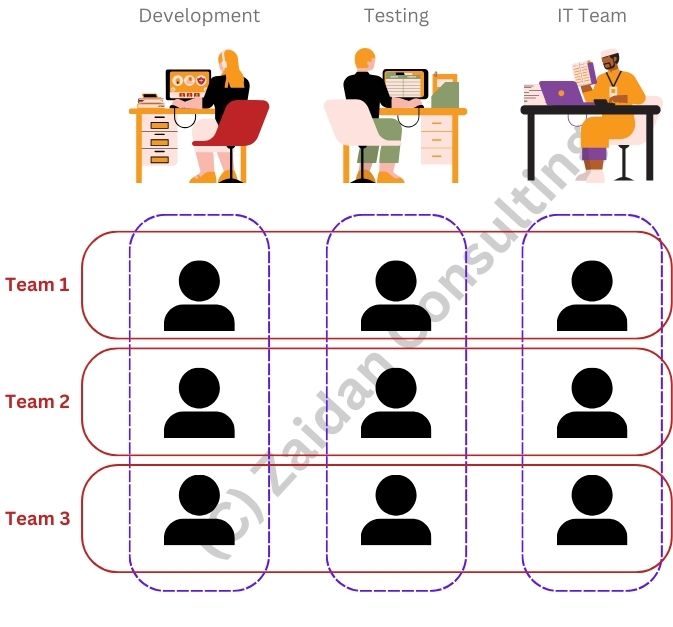
Well this kind of team is made up of people with all the skills required for delivering the outcome of the Project. The difference against the traditional team is that, the team members whether or not their home team is their respective department, they are committed first towards the current teams’ success. They are structured like in the diagram.
Software projects running on Agile practices behave cross functional by design.
Benefits

- Lesser bureaucracy: When traditional functional teams worked together, it was a cross department collaboration. All communication had to go through bureaucratic layers. And don’t forget these team members have their primary commitment with their respective departments. Now with this arrangement, the team members irrespective of their home team, have their shared goals as primary commitment.
- Faster turn around time: When all the ingredients necessary for releasing the increment of the Product readily available with-in the team, the speed at which you deliver is faster when you compare against the traditional team that had a legacy org structure.
- Efficient collaboration: This is the positive side effect of lesser bureaucracy. The team has at their disposal all the resources required, since these resources are not running on silos. One of the advantages of “Working Together”.
- Improved problem solving: Complex problems require multiple perspectives to arrive at possible set of solutions. There are always better ways than the approach you have come up with. When you have a cross functional team with different members with diverse skills, you get more creative.
- Faster decision making: Faster movement needs faster decision making. When all the stakeholders involved are sitting across the table, cross dependencies are resolved faster and decision making is swift. Hence keeping the team velocity fast and consistent.
- Better focus on common objective: Remember when we said, traditionally structured teams have their primary commitment towards their department goals. Well, that increases pressure on the management layer to exert focus on their respective resources who are part of the Project.
- Increased innovation: The problem with Skill/Competency based departments is that there is too much time, energy and resources spent on sharpening the skills rather than on domain problems the skills can solve. Instead a cross functional team focusses on the problem on hand and looks at how the combination of skills the team has can be used to solve the problem or even make efficient an existing use case.
Challenges
There are few cons for cross functional teams. Nevertheless, the pros outbid the cons by a long length. In fact many organizations would not mind with these cons.
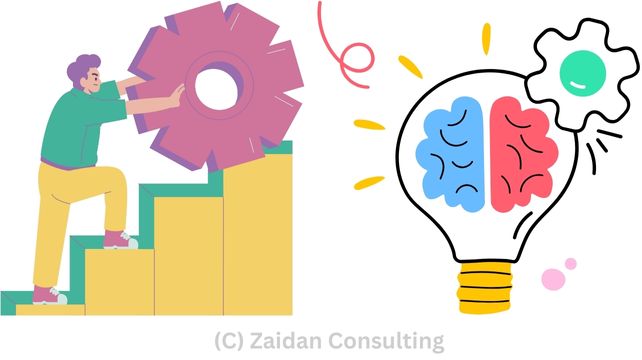
- Skill Modernization: The luxury that team members have with traditional skill based department of competency is that they have their special interest groups or equivalents where the resources get to sharpen their skills frequently. But this leverage is not available at least to the fuller extent in cross functional teams. Here the team focuses together on problem solving, which is great. But the skills and proficiency of the team members get stagnant over a period of time. Now, this can be avoided if the team members are passionate of the skills they posses and if they have intrinsic motivation to pursue excellence in their skill area.
- Lack of focus on shared goals: The very reason why we have cross functional team is that, the team focuses on use cases rather than issues in silos. Now, this could back fire if the goals are not properly articulated to the team members. Reasons could be lack of communication of vision, no well structured agenda for team ceremonies, improper education on the big picture of the Project to the team members, or even lack of touch points between the team members and the business owners.
Making an effective Cross Functional Team
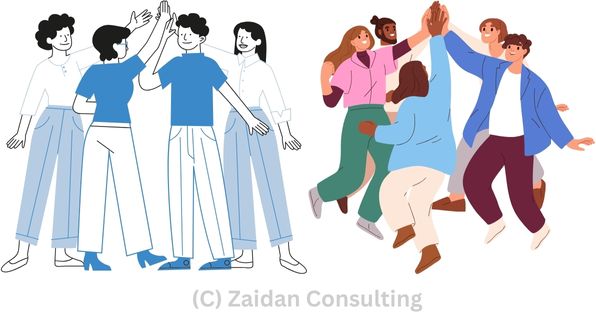
- Use the Team Charter: The Team Charter document is where together agrees on how they would work together. This includes how they communicate with each other, how they make decisions together, how they resolve conflicts between themselves. This document becomes even more important when the team’s skill diversity has a wider spectrum.
- Exploit the diversity: Talking about diversity, it bring varying perspectives from different team members. You need different points of you from people, particularly when you are solving problems or improving workflows.
- Set Shared Goals: The biggest challenge for Scrum Master running Agile team is to make sure the team members do not look at themselves as individuals, but rather identify themselves with the team. For this, the team members should have shared team level goals as their primary focus and any individual goals would become secondary.
- Discourage Hierarchy: If there is to be trust deficit between team members, the trust deficit must be down to “0”. Hierarchy introduces authority. And too many authority nodes in an org structure introduces fear of failure in the team. This is detrimental to modern teams, particularly those teams which follow agile practices.
- Autonomy on Decision Making: This is what we today call as self-organized teams. A self organized team is a team that plans, manages, executes, track their work together as a team. These teams take decisions together. In other words, they mostly come up with consensus based agreement. As discussed earlier faster the decision making process, the more agile you are.
- Encourage Healthy Conflicts: Disagreements is common when people work together. The trick lies in keeping the disagreement to the level where the conflict is on the problem and not between people. Intense discussions on technical and functional topics should be welcome, while moderation is necessary. A healthy conflict in a team is a sign of intersecting ideas in the team.
Conclusion
It is not necessary that every team has to be cross-functional. Certain organizations have a strong and narrowly focused goals, where the resources better be aligned with their respective department or competency.
Roles assigned to members of a Cross Functional team are less aligned with the Organization strategy and more aligned with the team goals. There are good chances that some organizations have teams that “evolved” into being cross-functional, without even knowing that they are “cross-functional”.
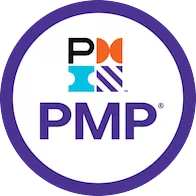
Our PMI® PMP®-Prep Course
If interested in this course, click here
- Case study based training
- LIVE instruction 36 Hours
- Post course guidance
- Exercise per topic
- 4 Mock exams for practice
- WhatsApp group support
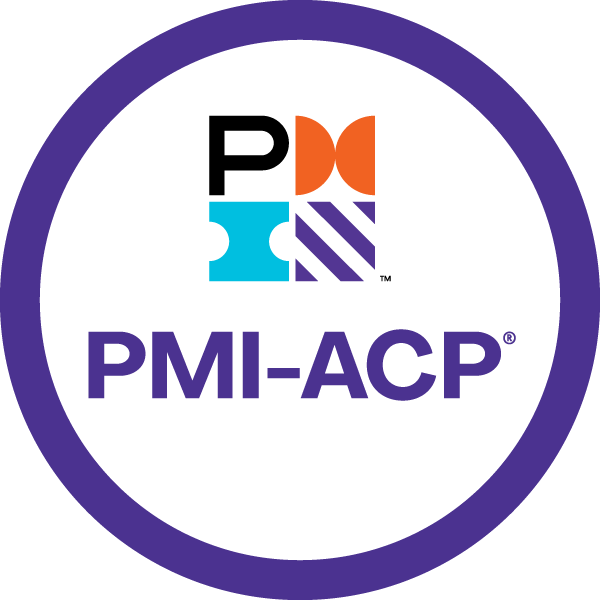
Our PMI® ACP®-Prep Course
If interested in this course, click here
- WhatsApp group support
- 4 Mock exams for practice
- Exercise per topic
- LIVE instruction 20 Hours
- Post course guidance
- Case study based training

JD (Coach/Instructor/Writer)
JD (a.k.a Janakiram) is a Project Management Coach, Trainer Author and Practitioner @Zaidan Consulting. He comes with around 17+ Years of experience primarily from the Software Industry. He is certified on PMI® PMP®, ACP®, Scrum Alliance CSM and Microsoft Certified Solution Developer on C#.NET. He has also authored the book “Practical Agile for Beginners”

About Zaidan Consulting
Zaidan Consulting are specialists in Project and Program Management space. Our training offerings include:
- Project Management Training
- Agile Training
- PMI®-ACP® Prep Training
- PMI®-PMP® Prep Training
- PMI®-CAPM® Prep Training
- ScrumStudy™ Authorized Training Partner (A.T.P)
Or you can contact us @+(91) 7672011471
Or Email us: contact@zaidanconsulting.com
